How to tell when apples are ripe and ready to pick?
Need help figuring out if your apples are ripe for picking? Read on for practical tips so there’s no guessing required.
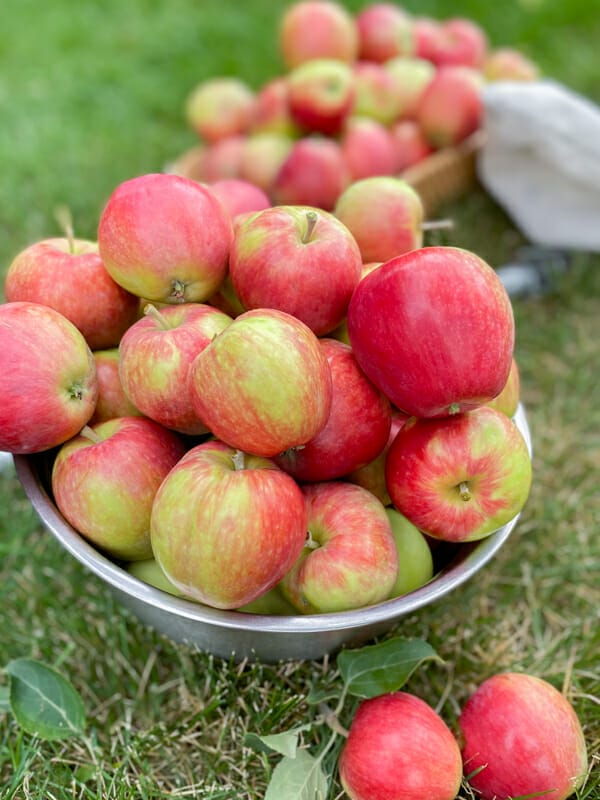
Learn more: 2 Ways to Make Applesauce, When & How to Harvest Grapes and How & When to Harvest Rhubarb.
Watch the Video: How to Tell When Apples are Ripe
How to Tell when your Apples are Ripe & Ready to Pick
Ingredients
- 1 Apple Tree
Instructions
Variety
- Knowing the variety of apple you have can help you narrow down WHEN you should start to consider whether or not your apples need picking.
- Apples and crab apples can typically be classified as early summer (July to mid August), mid-summer (mid-August to early September) or fall apples (mid-September to October).
- If you don’t know the variety, no problem, there are plenty of other ways to judge ripeness. Just don’t be fooled into picking your apples just because your neighbours are picking theirs! You may have a different variety and just because they’re picking, doesn’t mean you should!
- Start keeping tabs on your apple tree and soon you’ll get a sense of when your apples are typically ready to harvest. Although, some years there can be up to 3 to 4 week differences in harvest times.
Colour
- Look carefully at the colour of your apples, especially the base or ground colour – it may be green, creamy or yellow.
- Watch it change as the apples mature and wait for the entire apple to change.
- Unless you have a green apple variety like Granny Smith, most apples will turn a softer shade of green or even a creamy yellow when they’re fully ripe.
- For example, a Prairie Sensation apple in early July – they’re often a good size and have the START of a red blush, but the base colour is much too green.
Ease of Separation
- Ripe apples come off a tree quite easily – they don’t need to be tugged or pulled. Simply hold the bottom of the apple, lift it against the stem and twist. If it doesn’t come off easily, it’s not ripe.
Pip Colour
- Pick an apple and slice it open to see what colour the pips or seeds are. A ripe apple, no matter what size or variety, will have dark brown pips. Here’s the pips in one of our apples that fell off the tree mid-July. Notice that one seed is just starting to turn brown while the two beside it are still white. Even though the apple fell off the tree, it is no where near being ripe enough to pick.
- Keep testing and tasting your apples, it’s amazing how quickly they can ripen when conditions are hot and sunny. Take photos or just keep tabs on what your ideal apple looks and tastes like and after a couple of successful harvests you’ll know exactly what to look for.
Flavour/Taste
- Use an old fashioned taste test to judge the ripeness of your apples. Unless you have a crab apple or a tart apple variety, your apples should not be sour and make you pucker. It’s amazing how much sweeter your apples will become with a couple of days of sunshine.
Video
Notes
Five Tips for How to Tell Apples Are Ripe
Here are five tips from the Apple Cookbook on how to tell if your apples are ripe for picking.
1. Variety
Knowing the variety of apple you have can help you narrow down when you should start to consider whether or not your apples need picking. Apples and crab apples can typically be classified as early summer (July to mid August), mid-summer (mid-August to early September) or fall apples (mid-September to October).
If you don’t know the variety, no problem, there are plenty of other ways to judge ripeness. Just don’t be fooled into picking your apples just because your neighbours are picking theirs! You may have a different variety and just because they’re picking, doesn’t mean you should!
Start keeping tabs on your apple tree and soon you’ll get a sense of when your apples are typically ready to harvest. Although, some years there can be up to 3 to 4 week differences in harvest times.
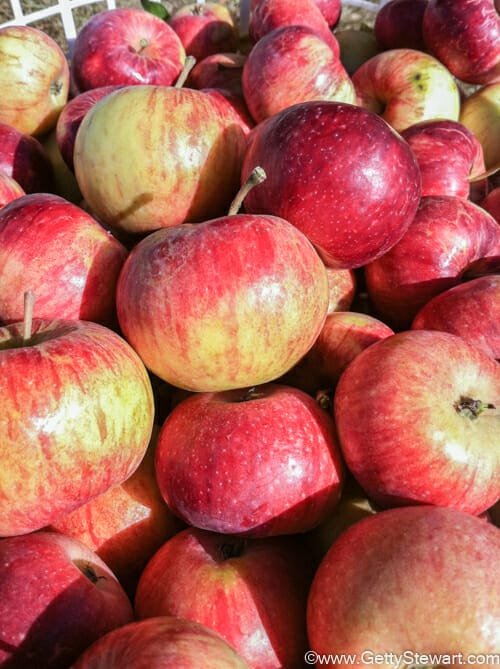
Did you know that some apples are best when picked after a frost? You bet! These red fall apples (variety may be a Haralson or Frostbite from the University of Minnesota) are super sweet and store really well, but aren’t harvested until mid-October.
These Goodland apples are often ready towards late August. They should be yellow with a blush of red.
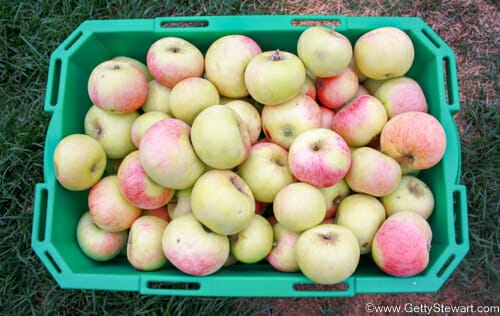
These rescue crab apples are one of the first to ripen in early August. The ones here are over ripe and have become grainy, but still good for juicing.
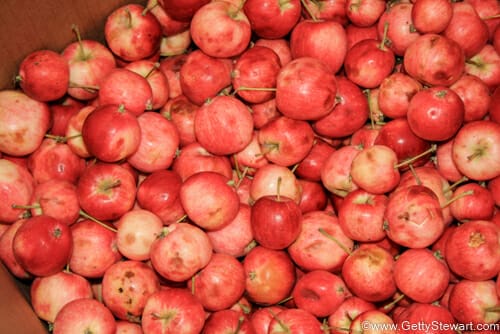
2. Colour
Look carefully at the colour of your apples, especially the base or ground colour – it may be green, creamy or yellow. Watch it change as the apples mature and wait for the entire apple to change. Unless you have a green apple variety like Granny Smith, most apples will turn a softer shade of green or even a creamy yellow when they’re fully ripe.
Here’s what our Prairie Sensation apples look like in early July. They’re a good size and have the start of a red blush, but the base colour is much too green.
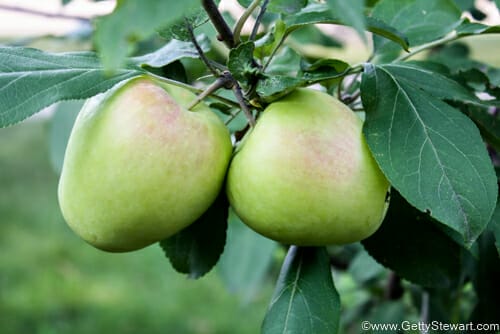
Here’s that same apple three weeks later, in August. Quite a difference, but if you’re not patient enough, you’d miss out on this transformation and would assume you have a tart green apple instead of the sweet delicious red apple you could enjoy if you wait.

3. Ease of Separation from Tree
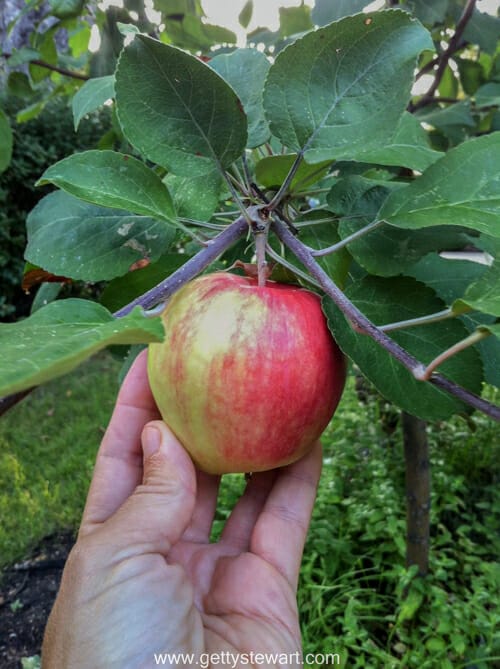
Ripe apples come off a tree quite easily – they don’t need to be tugged or pulled. Simply hold the bottom of the apple, lift it against the stem and twist. If it doesn’t come off easily, it’s not ripe.
4. Flavour
Use an old fashioned taste test to judge the ripeness of your apples. Unless you have a crab apple or a tart apple variety, your apples should not be sour and make you pucker. It’s amazing how much sweeter your apples will become with a couple of days of sunshine.
Here on the prairies people often pick under ripe apples because they think all prairie apples are sour – which is totally untrue. We have some amazingly sweet apples – you just need to let them ripen!
But don’t wait too long! If you’re apples seem mealy, they’re over ripe.
5. Pip Colour
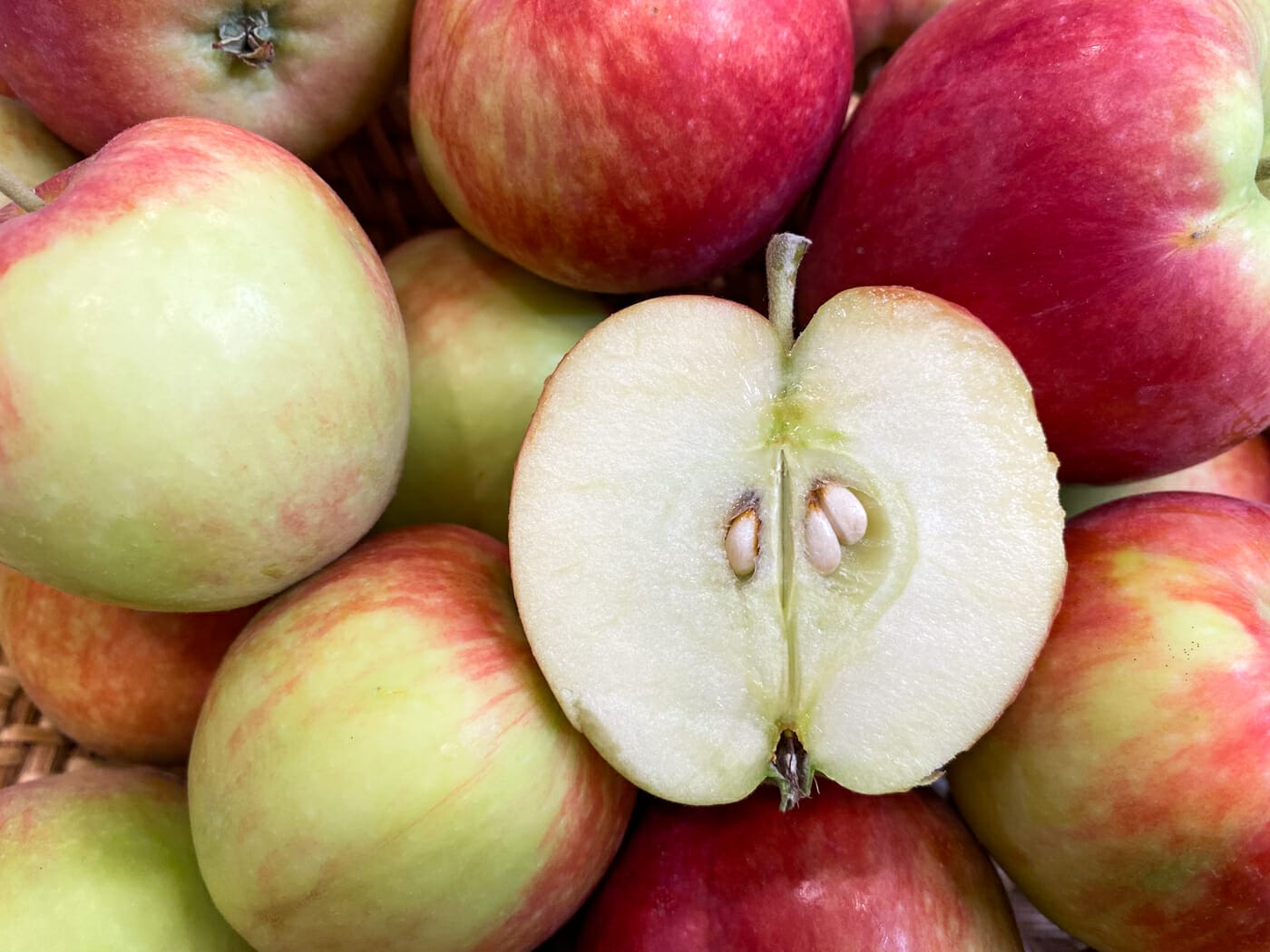
Pick an apple and slice it open to see what colour the pips or seeds are. A ripe apple, no matter what size or variety, will have dark brown pips. Here’s the pips in one of our apples that fell off the tree mid-July. Notice that one seed is just starting to turn brown while the two beside it are still white. Even though the apple fell off the tree, it is no where near being ripe enough to pick.
Keep testing and tasting your apples, it’s amazing how quickly they can ripen when conditions are hot and sunny. Take photos or just keep tabs on what your ideal apple looks and tastes like and after a couple of successful harvests you’ll know exactly what to look for.
Dropped Apples Don’t Mean They’re Ripe

I know it’s alarming when apples start dropping, but having some apples fall before they are ripe is normal. But it doesn’t necessarily mean the tree is ready for picking.
Do not judge ripeness by dropped apples alone. If a tree is suffering from environmental stress (too hot, cold, wet or dry), is overloaded or suffers from insect or wind damage it will drop apples prematurely. Use the tips listed above to determine ripeness.
Harvest Apples In Stages
Not all of the apples on a tree will be ready to harvest at the same time. Typically, apples along the outer edges of the tree will ripen before those towards the center of the tree. Ideally, you’d want to pick apples on more than one day, covering a span of one to two weeks. Picking in this manner will ensure you get consistently ripe apples.
But, I get it, sometimes you just want to pick them all and get on with it! If you’re juicing, saucing,baking or making jams and jellies with your apples, it’s okay to have a mix of overripe, underripe and just right apples. For this type of picking, you want to pick when the majority of apples are perfectly ripe.

Picking in Your Community
In the mood to pick some apples, but don’t have your own apple tree? Check out fruit rescuing organizations in your community that match up people interested in picking fruit with people who have too much fruit. Google fruit rescuing in your community. If there’s no formal fruit picking group, let friends, neighbors and social media know you’re looking to help someone pick their apples. There’s bound to be someone who has more apples than they can manage.
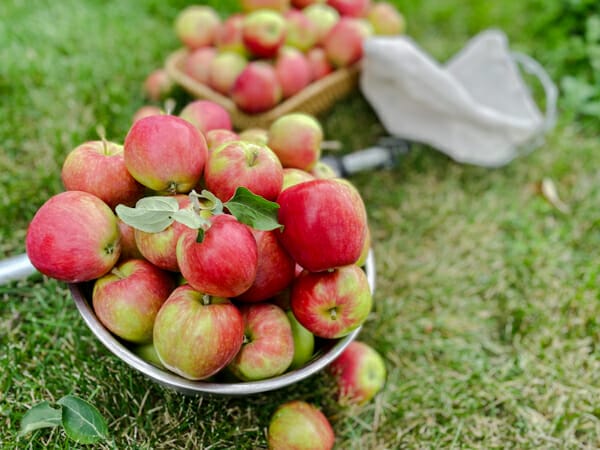
I LOVE local apples – not just the flavour, but the whole idea of them. After all, apples prompted me to launch Fruit Share – TedX Getty Stewart, write my fruit cookbooks and start this website. So please, share your apple pictures and stories with me! I’d love to hear your experiences (good or bad), see what varieties you’re growing and how you use your bounty. Share your comments below or post a photo and tag me on Instagram @getgettys or Facebook @GettyStewart.HomeEconomist.
Sign up to get articles by Getty delivered to your inbox. You’ll get recipes, practical tips and great food information like this. Getty is a Professional Home Economist, speaker and writer putting good food on tables and agendas. She is the author of Manitoba’s best-selling Prairie Fruit Cookbook, Founder of Fruit Share, a mom and veggie gardener.



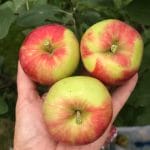
Hi! This article was SO helpful! We moved to a new home in February with two beautiful apple trees and one pear tree. Now I know when to pick them 🙂
Yay! So glad to be able to help! Enjoy those apples.
Great pointers on how to identify when an apple is ripe for the picking. Some people may get impatient waiting for ripe apples, but they’re more than worth the wait!
Yes! You’re absolutely right. People jump the gun because a few apples will start to drop early, but if you wait until they’re truly ripe they’re so much tastier!
Like to subscribe to your newsletters
Would love for you to join my list. Enter your email address at the top left column. If you’re on mobile, change to the desktop view and you’ll find the subscription at the top left under the main banner for my site. Thanks.